Energy Geopolitics: US and China Approaches, University Report
VerifiedAdded on 2020/01/23
|17
|4693
|92
Report
AI Summary
This report delves into the intricate field of energy geopolitics, examining the interplay between countries in the context of energy resources. It begins with an introduction to geopolitics and its relevance to global relations, followed by a literature review defining key concepts and exploring geopolitical theories, including the growing importance of non-conventional energy sources like renewable energy. The report analyzes the approaches of the United States and China in the geopolitics of energy, comparing their strategies and highlighting the significance of renewable energy in the global landscape. It also explores the rationale for the study, emphasizing the rising energy demands of countries like China, India, and Brazil, and the environmental benefits of renewable energy over conventional sources. The report provides insights into the development of renewable energy globally and concludes with a discussion on the future of energy geopolitics. This comprehensive analysis is essential for understanding the evolving dynamics of power and resources in the 21st century.
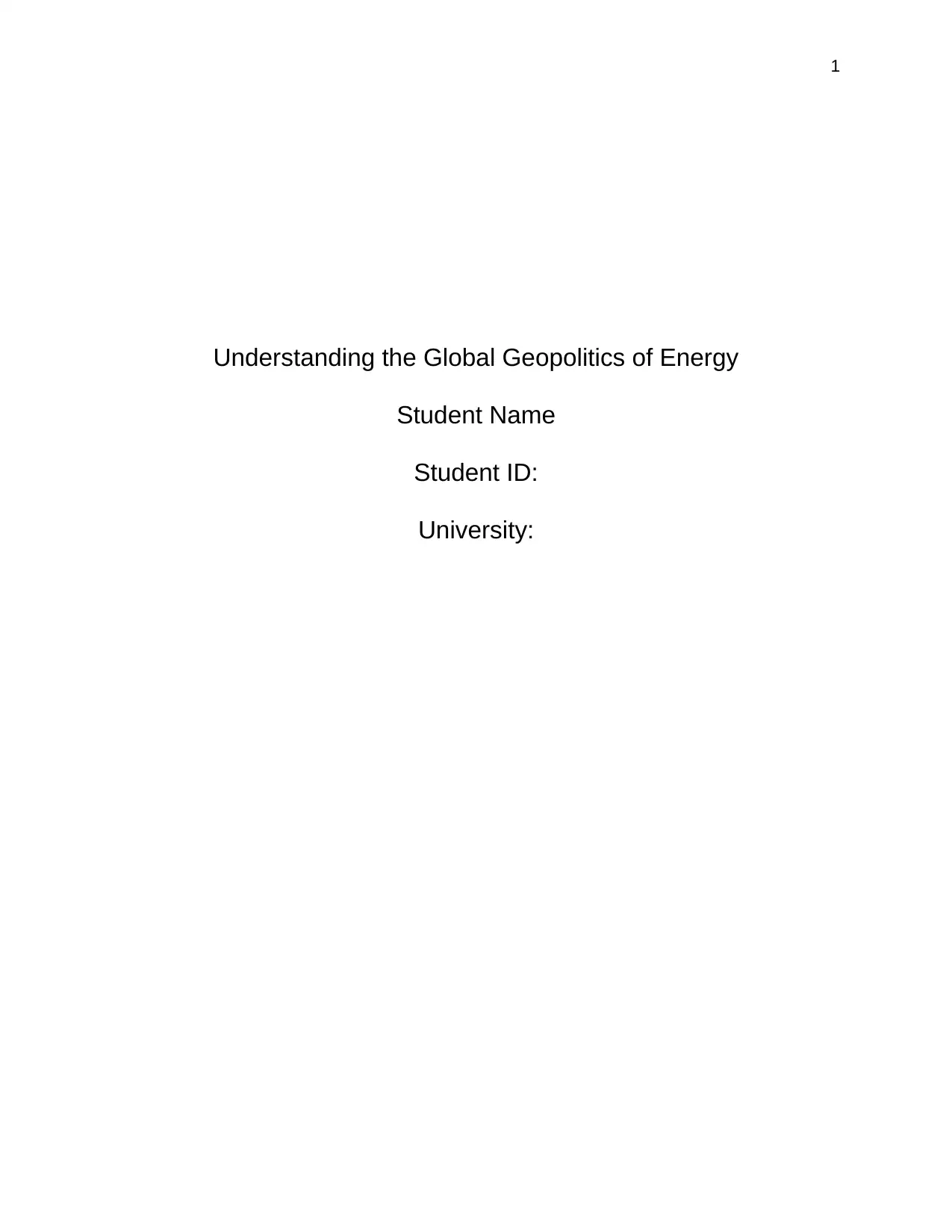
1
Understanding the Global Geopolitics of Energy
Student Name
Student ID:
University:
Understanding the Global Geopolitics of Energy
Student Name
Student ID:
University:
Paraphrase This Document
Need a fresh take? Get an instant paraphrase of this document with our AI Paraphraser
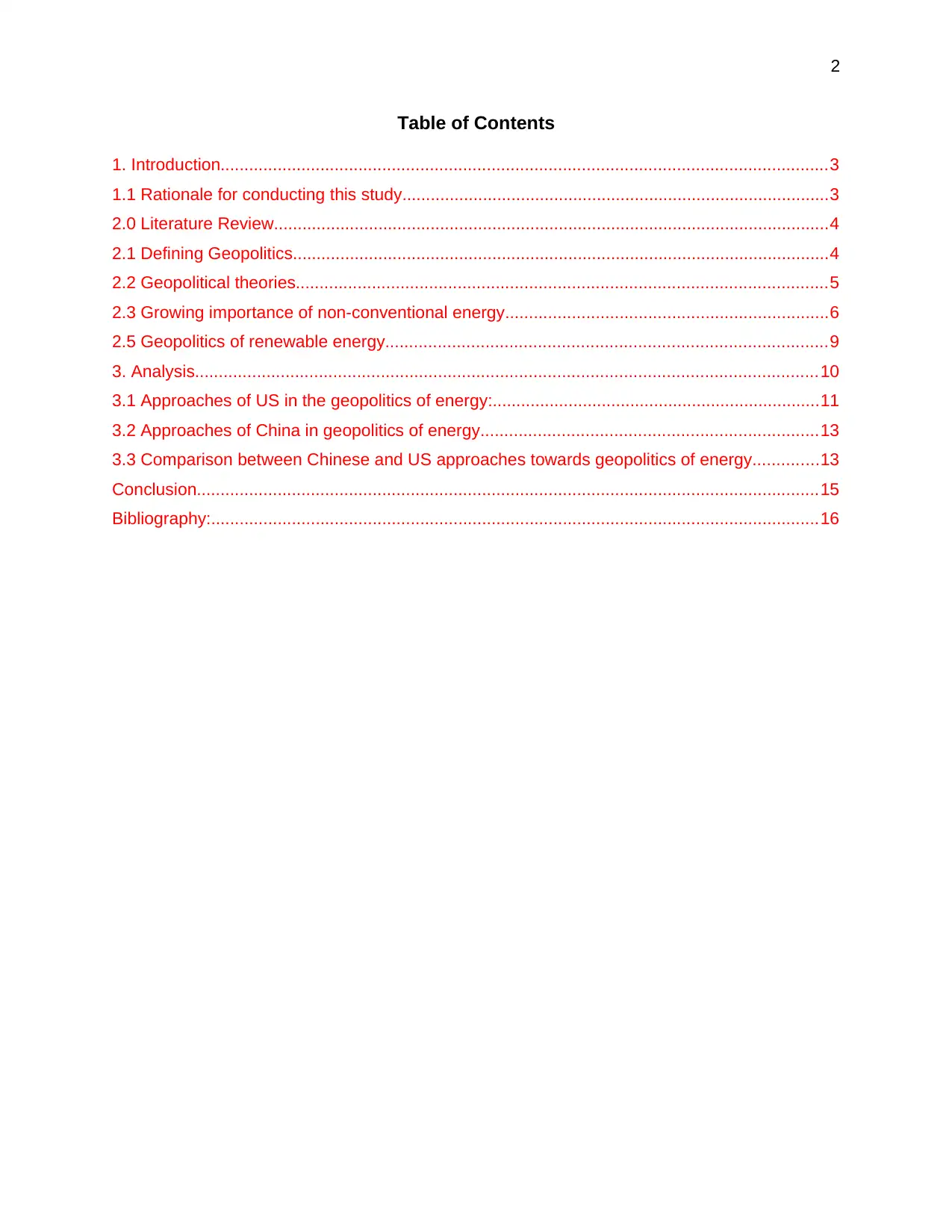
2
Table of Contents
1. Introduction................................................................................................................................3
1.1 Rationale for conducting this study..........................................................................................3
2.0 Literature Review.....................................................................................................................4
2.1 Defining Geopolitics.................................................................................................................4
2.2 Geopolitical theories................................................................................................................5
2.3 Growing importance of non-conventional energy....................................................................6
2.5 Geopolitics of renewable energy.............................................................................................9
3. Analysis...................................................................................................................................10
3.1 Approaches of US in the geopolitics of energy:.....................................................................11
3.2 Approaches of China in geopolitics of energy.......................................................................13
3.3 Comparison between Chinese and US approaches towards geopolitics of energy..............13
Conclusion...................................................................................................................................15
Bibliography:................................................................................................................................16
Table of Contents
1. Introduction................................................................................................................................3
1.1 Rationale for conducting this study..........................................................................................3
2.0 Literature Review.....................................................................................................................4
2.1 Defining Geopolitics.................................................................................................................4
2.2 Geopolitical theories................................................................................................................5
2.3 Growing importance of non-conventional energy....................................................................6
2.5 Geopolitics of renewable energy.............................................................................................9
3. Analysis...................................................................................................................................10
3.1 Approaches of US in the geopolitics of energy:.....................................................................11
3.2 Approaches of China in geopolitics of energy.......................................................................13
3.3 Comparison between Chinese and US approaches towards geopolitics of energy..............13
Conclusion...................................................................................................................................15
Bibliography:................................................................................................................................16
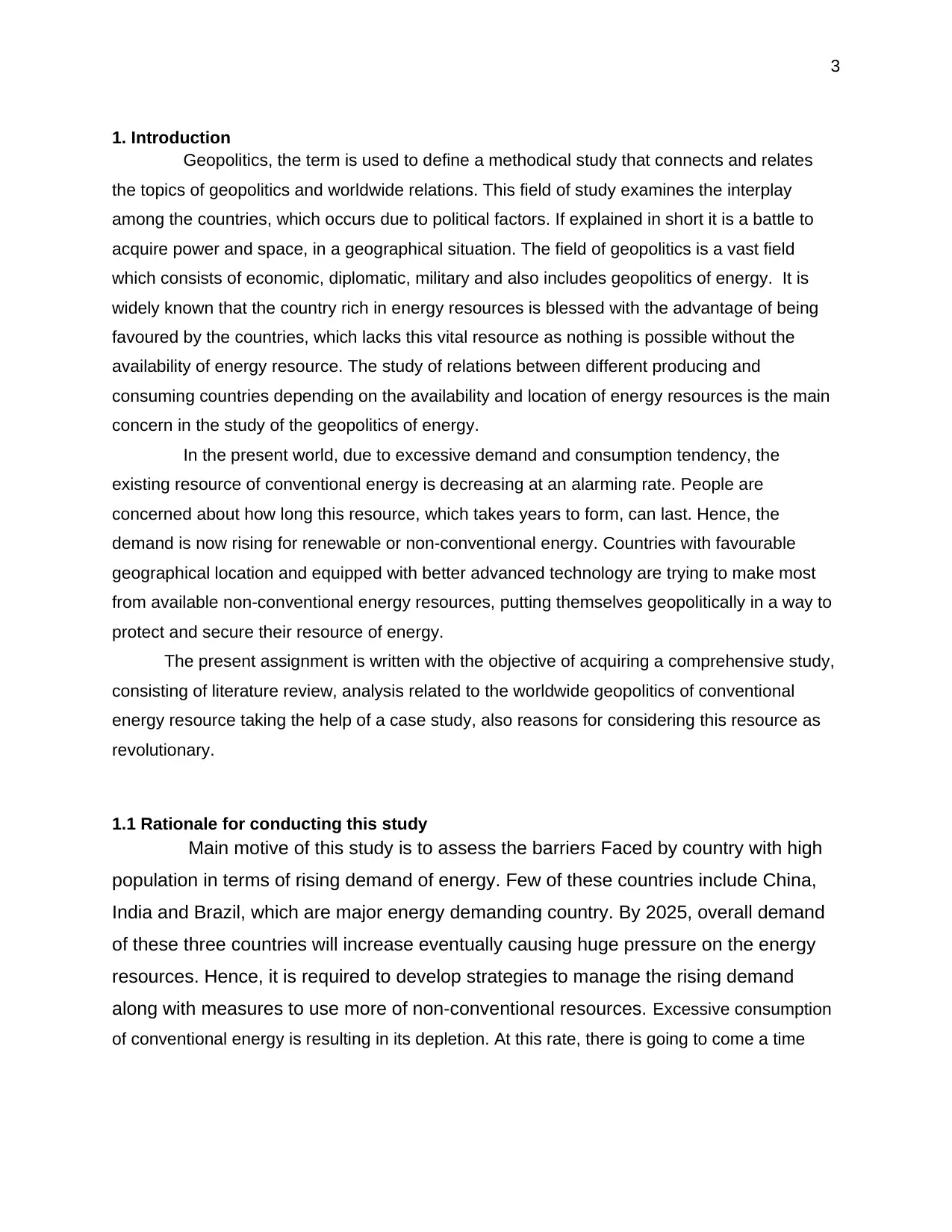
3
1. Introduction
Geopolitics, the term is used to define a methodical study that connects and relates
the topics of geopolitics and worldwide relations. This field of study examines the interplay
among the countries, which occurs due to political factors. If explained in short it is a battle to
acquire power and space, in a geographical situation. The field of geopolitics is a vast field
which consists of economic, diplomatic, military and also includes geopolitics of energy. It is
widely known that the country rich in energy resources is blessed with the advantage of being
favoured by the countries, which lacks this vital resource as nothing is possible without the
availability of energy resource. The study of relations between different producing and
consuming countries depending on the availability and location of energy resources is the main
concern in the study of the geopolitics of energy.
In the present world, due to excessive demand and consumption tendency, the
existing resource of conventional energy is decreasing at an alarming rate. People are
concerned about how long this resource, which takes years to form, can last. Hence, the
demand is now rising for renewable or non-conventional energy. Countries with favourable
geographical location and equipped with better advanced technology are trying to make most
from available non-conventional energy resources, putting themselves geopolitically in a way to
protect and secure their resource of energy.
The present assignment is written with the objective of acquiring a comprehensive study,
consisting of literature review, analysis related to the worldwide geopolitics of conventional
energy resource taking the help of a case study, also reasons for considering this resource as
revolutionary.
1.1 Rationale for conducting this study
Main motive of this study is to assess the barriers Faced by country with high
population in terms of rising demand of energy. Few of these countries include China,
India and Brazil, which are major energy demanding country. By 2025, overall demand
of these three countries will increase eventually causing huge pressure on the energy
resources. Hence, it is required to develop strategies to manage the rising demand
along with measures to use more of non-conventional resources. Excessive consumption
of conventional energy is resulting in its depletion. At this rate, there is going to come a time
1. Introduction
Geopolitics, the term is used to define a methodical study that connects and relates
the topics of geopolitics and worldwide relations. This field of study examines the interplay
among the countries, which occurs due to political factors. If explained in short it is a battle to
acquire power and space, in a geographical situation. The field of geopolitics is a vast field
which consists of economic, diplomatic, military and also includes geopolitics of energy. It is
widely known that the country rich in energy resources is blessed with the advantage of being
favoured by the countries, which lacks this vital resource as nothing is possible without the
availability of energy resource. The study of relations between different producing and
consuming countries depending on the availability and location of energy resources is the main
concern in the study of the geopolitics of energy.
In the present world, due to excessive demand and consumption tendency, the
existing resource of conventional energy is decreasing at an alarming rate. People are
concerned about how long this resource, which takes years to form, can last. Hence, the
demand is now rising for renewable or non-conventional energy. Countries with favourable
geographical location and equipped with better advanced technology are trying to make most
from available non-conventional energy resources, putting themselves geopolitically in a way to
protect and secure their resource of energy.
The present assignment is written with the objective of acquiring a comprehensive study,
consisting of literature review, analysis related to the worldwide geopolitics of conventional
energy resource taking the help of a case study, also reasons for considering this resource as
revolutionary.
1.1 Rationale for conducting this study
Main motive of this study is to assess the barriers Faced by country with high
population in terms of rising demand of energy. Few of these countries include China,
India and Brazil, which are major energy demanding country. By 2025, overall demand
of these three countries will increase eventually causing huge pressure on the energy
resources. Hence, it is required to develop strategies to manage the rising demand
along with measures to use more of non-conventional resources. Excessive consumption
of conventional energy is resulting in its depletion. At this rate, there is going to come a time
⊘ This is a preview!⊘
Do you want full access?
Subscribe today to unlock all pages.

Trusted by 1+ million students worldwide
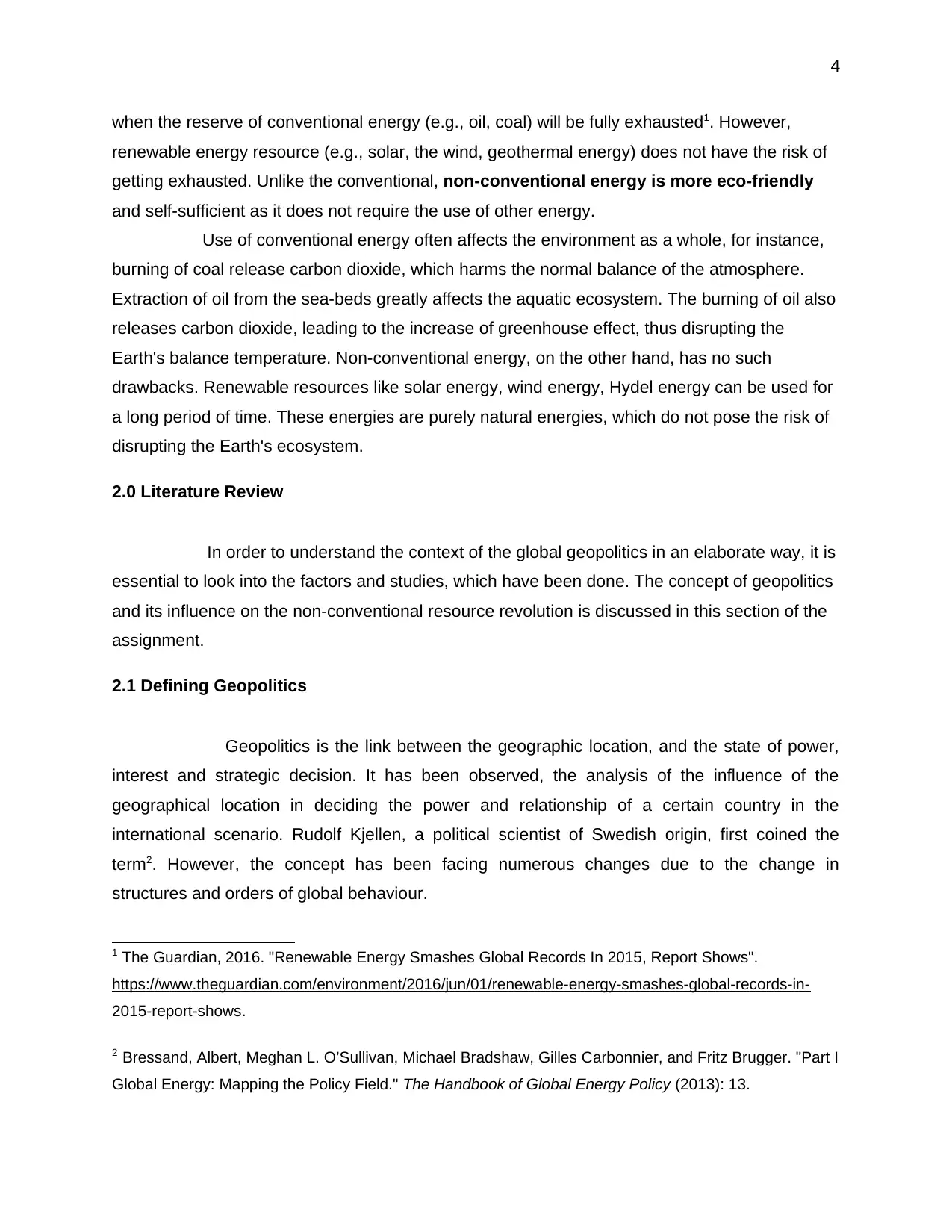
4
when the reserve of conventional energy (e.g., oil, coal) will be fully exhausted1. However,
renewable energy resource (e.g., solar, the wind, geothermal energy) does not have the risk of
getting exhausted. Unlike the conventional, non-conventional energy is more eco-friendly
and self-sufficient as it does not require the use of other energy.
Use of conventional energy often affects the environment as a whole, for instance,
burning of coal release carbon dioxide, which harms the normal balance of the atmosphere.
Extraction of oil from the sea-beds greatly affects the aquatic ecosystem. The burning of oil also
releases carbon dioxide, leading to the increase of greenhouse effect, thus disrupting the
Earth's balance temperature. Non-conventional energy, on the other hand, has no such
drawbacks. Renewable resources like solar energy, wind energy, Hydel energy can be used for
a long period of time. These energies are purely natural energies, which do not pose the risk of
disrupting the Earth's ecosystem.
2.0 Literature Review
In order to understand the context of the global geopolitics in an elaborate way, it is
essential to look into the factors and studies, which have been done. The concept of geopolitics
and its influence on the non-conventional resource revolution is discussed in this section of the
assignment.
2.1 Defining Geopolitics
Geopolitics is the link between the geographic location, and the state of power,
interest and strategic decision. It has been observed, the analysis of the influence of the
geographical location in deciding the power and relationship of a certain country in the
international scenario. Rudolf Kjellen, a political scientist of Swedish origin, first coined the
term2. However, the concept has been facing numerous changes due to the change in
structures and orders of global behaviour.
1 The Guardian, 2016. "Renewable Energy Smashes Global Records In 2015, Report Shows".
https://www.theguardian.com/environment/2016/jun/01/renewable-energy-smashes-global-records-in-
2015-report-shows.
2 Bressand, Albert, Meghan L. O’Sullivan, Michael Bradshaw, Gilles Carbonnier, and Fritz Brugger. "Part I
Global Energy: Mapping the Policy Field." The Handbook of Global Energy Policy (2013): 13.
when the reserve of conventional energy (e.g., oil, coal) will be fully exhausted1. However,
renewable energy resource (e.g., solar, the wind, geothermal energy) does not have the risk of
getting exhausted. Unlike the conventional, non-conventional energy is more eco-friendly
and self-sufficient as it does not require the use of other energy.
Use of conventional energy often affects the environment as a whole, for instance,
burning of coal release carbon dioxide, which harms the normal balance of the atmosphere.
Extraction of oil from the sea-beds greatly affects the aquatic ecosystem. The burning of oil also
releases carbon dioxide, leading to the increase of greenhouse effect, thus disrupting the
Earth's balance temperature. Non-conventional energy, on the other hand, has no such
drawbacks. Renewable resources like solar energy, wind energy, Hydel energy can be used for
a long period of time. These energies are purely natural energies, which do not pose the risk of
disrupting the Earth's ecosystem.
2.0 Literature Review
In order to understand the context of the global geopolitics in an elaborate way, it is
essential to look into the factors and studies, which have been done. The concept of geopolitics
and its influence on the non-conventional resource revolution is discussed in this section of the
assignment.
2.1 Defining Geopolitics
Geopolitics is the link between the geographic location, and the state of power,
interest and strategic decision. It has been observed, the analysis of the influence of the
geographical location in deciding the power and relationship of a certain country in the
international scenario. Rudolf Kjellen, a political scientist of Swedish origin, first coined the
term2. However, the concept has been facing numerous changes due to the change in
structures and orders of global behaviour.
1 The Guardian, 2016. "Renewable Energy Smashes Global Records In 2015, Report Shows".
https://www.theguardian.com/environment/2016/jun/01/renewable-energy-smashes-global-records-in-
2015-report-shows.
2 Bressand, Albert, Meghan L. O’Sullivan, Michael Bradshaw, Gilles Carbonnier, and Fritz Brugger. "Part I
Global Energy: Mapping the Policy Field." The Handbook of Global Energy Policy (2013): 13.
Paraphrase This Document
Need a fresh take? Get an instant paraphrase of this document with our AI Paraphraser
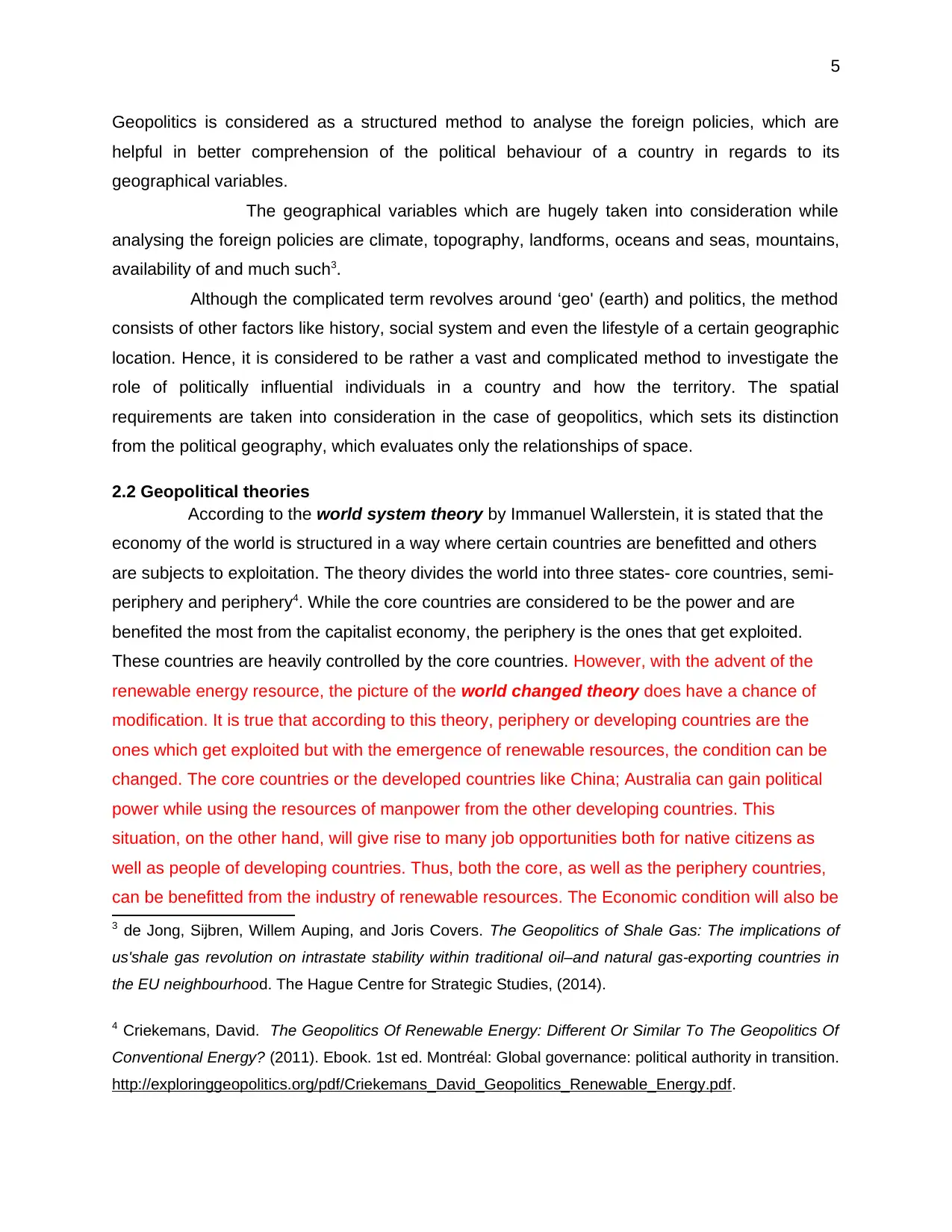
5
Geopolitics is considered as a structured method to analyse the foreign policies, which are
helpful in better comprehension of the political behaviour of a country in regards to its
geographical variables.
The geographical variables which are hugely taken into consideration while
analysing the foreign policies are climate, topography, landforms, oceans and seas, mountains,
availability of and much such3.
Although the complicated term revolves around ‘geo' (earth) and politics, the method
consists of other factors like history, social system and even the lifestyle of a certain geographic
location. Hence, it is considered to be rather a vast and complicated method to investigate the
role of politically influential individuals in a country and how the territory. The spatial
requirements are taken into consideration in the case of geopolitics, which sets its distinction
from the political geography, which evaluates only the relationships of space.
2.2 Geopolitical theories
According to the world system theory by Immanuel Wallerstein, it is stated that the
economy of the world is structured in a way where certain countries are benefitted and others
are subjects to exploitation. The theory divides the world into three states- core countries, semi-
periphery and periphery4. While the core countries are considered to be the power and are
benefited the most from the capitalist economy, the periphery is the ones that get exploited.
These countries are heavily controlled by the core countries. However, with the advent of the
renewable energy resource, the picture of the world changed theory does have a chance of
modification. It is true that according to this theory, periphery or developing countries are the
ones which get exploited but with the emergence of renewable resources, the condition can be
changed. The core countries or the developed countries like China; Australia can gain political
power while using the resources of manpower from the other developing countries. This
situation, on the other hand, will give rise to many job opportunities both for native citizens as
well as people of developing countries. Thus, both the core, as well as the periphery countries,
can be benefitted from the industry of renewable resources. The Economic condition will also be
3 de Jong, Sijbren, Willem Auping, and Joris Covers. The Geopolitics of Shale Gas: The implications of
us'shale gas revolution on intrastate stability within traditional oil–and natural gas-exporting countries in
the EU neighbourhood. The Hague Centre for Strategic Studies, (2014).
4 Criekemans, David. The Geopolitics Of Renewable Energy: Different Or Similar To The Geopolitics Of
Conventional Energy? (2011). Ebook. 1st ed. Montréal: Global governance: political authority in transition.
http://exploringgeopolitics.org/pdf/Criekemans_David_Geopolitics_Renewable_Energy.pdf.
Geopolitics is considered as a structured method to analyse the foreign policies, which are
helpful in better comprehension of the political behaviour of a country in regards to its
geographical variables.
The geographical variables which are hugely taken into consideration while
analysing the foreign policies are climate, topography, landforms, oceans and seas, mountains,
availability of and much such3.
Although the complicated term revolves around ‘geo' (earth) and politics, the method
consists of other factors like history, social system and even the lifestyle of a certain geographic
location. Hence, it is considered to be rather a vast and complicated method to investigate the
role of politically influential individuals in a country and how the territory. The spatial
requirements are taken into consideration in the case of geopolitics, which sets its distinction
from the political geography, which evaluates only the relationships of space.
2.2 Geopolitical theories
According to the world system theory by Immanuel Wallerstein, it is stated that the
economy of the world is structured in a way where certain countries are benefitted and others
are subjects to exploitation. The theory divides the world into three states- core countries, semi-
periphery and periphery4. While the core countries are considered to be the power and are
benefited the most from the capitalist economy, the periphery is the ones that get exploited.
These countries are heavily controlled by the core countries. However, with the advent of the
renewable energy resource, the picture of the world changed theory does have a chance of
modification. It is true that according to this theory, periphery or developing countries are the
ones which get exploited but with the emergence of renewable resources, the condition can be
changed. The core countries or the developed countries like China; Australia can gain political
power while using the resources of manpower from the other developing countries. This
situation, on the other hand, will give rise to many job opportunities both for native citizens as
well as people of developing countries. Thus, both the core, as well as the periphery countries,
can be benefitted from the industry of renewable resources. The Economic condition will also be
3 de Jong, Sijbren, Willem Auping, and Joris Covers. The Geopolitics of Shale Gas: The implications of
us'shale gas revolution on intrastate stability within traditional oil–and natural gas-exporting countries in
the EU neighbourhood. The Hague Centre for Strategic Studies, (2014).
4 Criekemans, David. The Geopolitics Of Renewable Energy: Different Or Similar To The Geopolitics Of
Conventional Energy? (2011). Ebook. 1st ed. Montréal: Global governance: political authority in transition.
http://exploringgeopolitics.org/pdf/Criekemans_David_Geopolitics_Renewable_Energy.pdf.
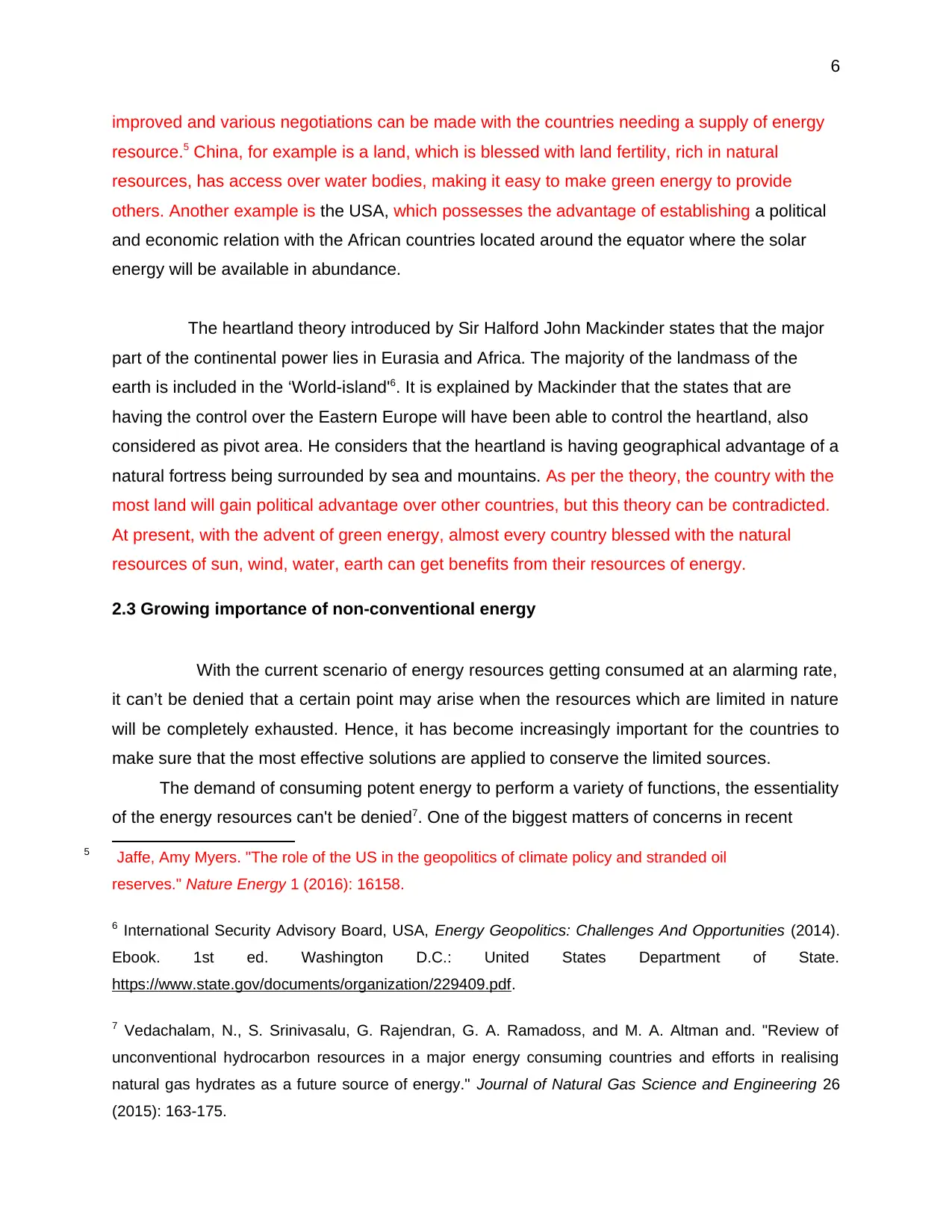
6
improved and various negotiations can be made with the countries needing a supply of energy
resource.5 China, for example is a land, which is blessed with land fertility, rich in natural
resources, has access over water bodies, making it easy to make green energy to provide
others. Another example is the USA, which possesses the advantage of establishing a political
and economic relation with the African countries located around the equator where the solar
energy will be available in abundance.
The heartland theory introduced by Sir Halford John Mackinder states that the major
part of the continental power lies in Eurasia and Africa. The majority of the landmass of the
earth is included in the ‘World-island'6. It is explained by Mackinder that the states that are
having the control over the Eastern Europe will have been able to control the heartland, also
considered as pivot area. He considers that the heartland is having geographical advantage of a
natural fortress being surrounded by sea and mountains. As per the theory, the country with the
most land will gain political advantage over other countries, but this theory can be contradicted.
At present, with the advent of green energy, almost every country blessed with the natural
resources of sun, wind, water, earth can get benefits from their resources of energy.
2.3 Growing importance of non-conventional energy
With the current scenario of energy resources getting consumed at an alarming rate,
it can’t be denied that a certain point may arise when the resources which are limited in nature
will be completely exhausted. Hence, it has become increasingly important for the countries to
make sure that the most effective solutions are applied to conserve the limited sources.
The demand of consuming potent energy to perform a variety of functions, the essentiality
of the energy resources can't be denied7. One of the biggest matters of concerns in recent
5 Jaffe, Amy Myers. "The role of the US in the geopolitics of climate policy and stranded oil
reserves." Nature Energy 1 (2016): 16158.
6 International Security Advisory Board, USA, Energy Geopolitics: Challenges And Opportunities (2014).
Ebook. 1st ed. Washington D.C.: United States Department of State.
https://www.state.gov/documents/organization/229409.pdf.
7 Vedachalam, N., S. Srinivasalu, G. Rajendran, G. A. Ramadoss, and M. A. Altman and. "Review of
unconventional hydrocarbon resources in a major energy consuming countries and efforts in realising
natural gas hydrates as a future source of energy." Journal of Natural Gas Science and Engineering 26
(2015): 163-175.
improved and various negotiations can be made with the countries needing a supply of energy
resource.5 China, for example is a land, which is blessed with land fertility, rich in natural
resources, has access over water bodies, making it easy to make green energy to provide
others. Another example is the USA, which possesses the advantage of establishing a political
and economic relation with the African countries located around the equator where the solar
energy will be available in abundance.
The heartland theory introduced by Sir Halford John Mackinder states that the major
part of the continental power lies in Eurasia and Africa. The majority of the landmass of the
earth is included in the ‘World-island'6. It is explained by Mackinder that the states that are
having the control over the Eastern Europe will have been able to control the heartland, also
considered as pivot area. He considers that the heartland is having geographical advantage of a
natural fortress being surrounded by sea and mountains. As per the theory, the country with the
most land will gain political advantage over other countries, but this theory can be contradicted.
At present, with the advent of green energy, almost every country blessed with the natural
resources of sun, wind, water, earth can get benefits from their resources of energy.
2.3 Growing importance of non-conventional energy
With the current scenario of energy resources getting consumed at an alarming rate,
it can’t be denied that a certain point may arise when the resources which are limited in nature
will be completely exhausted. Hence, it has become increasingly important for the countries to
make sure that the most effective solutions are applied to conserve the limited sources.
The demand of consuming potent energy to perform a variety of functions, the essentiality
of the energy resources can't be denied7. One of the biggest matters of concerns in recent
5 Jaffe, Amy Myers. "The role of the US in the geopolitics of climate policy and stranded oil
reserves." Nature Energy 1 (2016): 16158.
6 International Security Advisory Board, USA, Energy Geopolitics: Challenges And Opportunities (2014).
Ebook. 1st ed. Washington D.C.: United States Department of State.
https://www.state.gov/documents/organization/229409.pdf.
7 Vedachalam, N., S. Srinivasalu, G. Rajendran, G. A. Ramadoss, and M. A. Altman and. "Review of
unconventional hydrocarbon resources in a major energy consuming countries and efforts in realising
natural gas hydrates as a future source of energy." Journal of Natural Gas Science and Engineering 26
(2015): 163-175.
⊘ This is a preview!⊘
Do you want full access?
Subscribe today to unlock all pages.

Trusted by 1+ million students worldwide
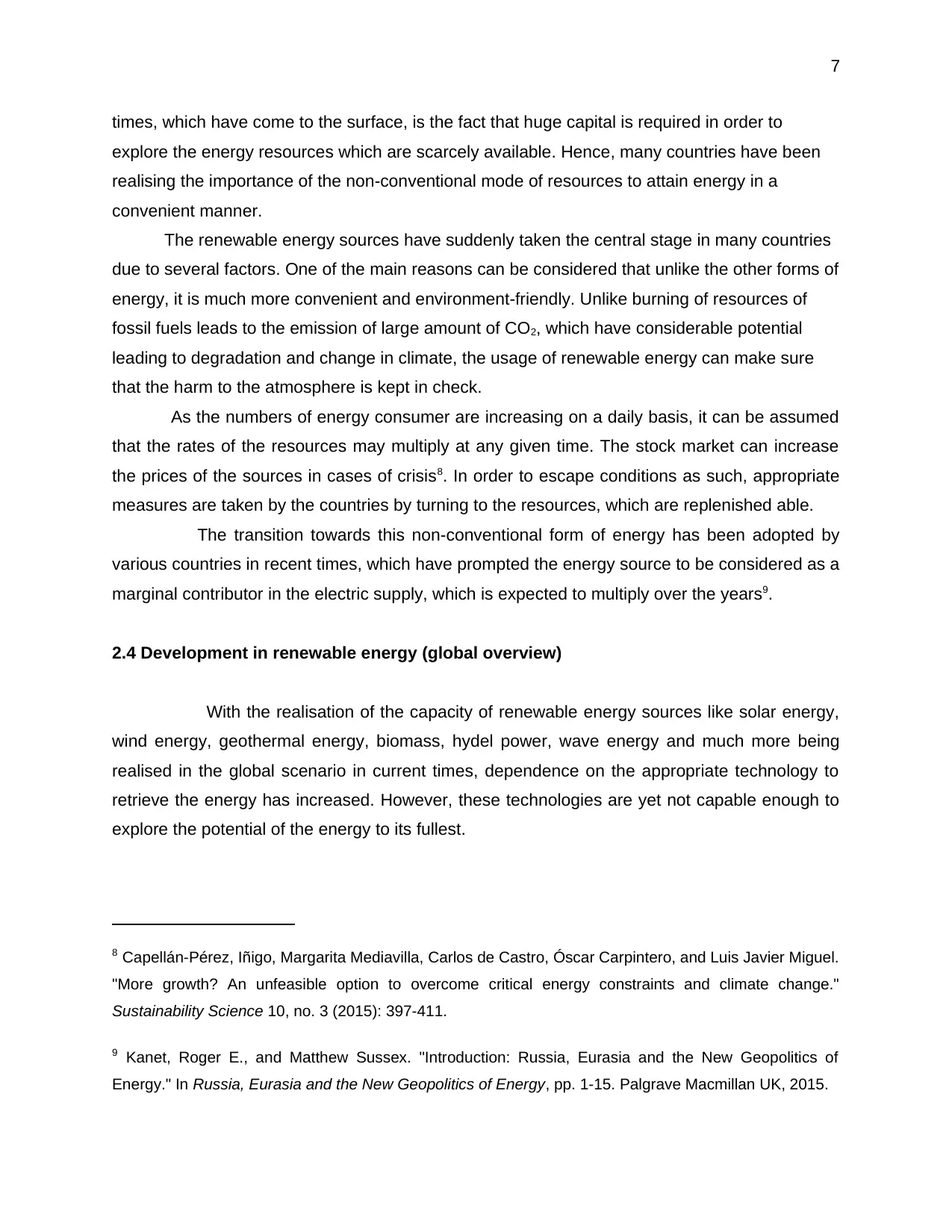
7
times, which have come to the surface, is the fact that huge capital is required in order to
explore the energy resources which are scarcely available. Hence, many countries have been
realising the importance of the non-conventional mode of resources to attain energy in a
convenient manner.
The renewable energy sources have suddenly taken the central stage in many countries
due to several factors. One of the main reasons can be considered that unlike the other forms of
energy, it is much more convenient and environment-friendly. Unlike burning of resources of
fossil fuels leads to the emission of large amount of CO2, which have considerable potential
leading to degradation and change in climate, the usage of renewable energy can make sure
that the harm to the atmosphere is kept in check.
As the numbers of energy consumer are increasing on a daily basis, it can be assumed
that the rates of the resources may multiply at any given time. The stock market can increase
the prices of the sources in cases of crisis8. In order to escape conditions as such, appropriate
measures are taken by the countries by turning to the resources, which are replenished able.
The transition towards this non-conventional form of energy has been adopted by
various countries in recent times, which have prompted the energy source to be considered as a
marginal contributor in the electric supply, which is expected to multiply over the years9.
2.4 Development in renewable energy (global overview)
With the realisation of the capacity of renewable energy sources like solar energy,
wind energy, geothermal energy, biomass, hydel power, wave energy and much more being
realised in the global scenario in current times, dependence on the appropriate technology to
retrieve the energy has increased. However, these technologies are yet not capable enough to
explore the potential of the energy to its fullest.
8 Capellán-Pérez, Iñigo, Margarita Mediavilla, Carlos de Castro, Óscar Carpintero, and Luis Javier Miguel.
"More growth? An unfeasible option to overcome critical energy constraints and climate change."
Sustainability Science 10, no. 3 (2015): 397-411.
9 Kanet, Roger E., and Matthew Sussex. "Introduction: Russia, Eurasia and the New Geopolitics of
Energy." In Russia, Eurasia and the New Geopolitics of Energy, pp. 1-15. Palgrave Macmillan UK, 2015.
times, which have come to the surface, is the fact that huge capital is required in order to
explore the energy resources which are scarcely available. Hence, many countries have been
realising the importance of the non-conventional mode of resources to attain energy in a
convenient manner.
The renewable energy sources have suddenly taken the central stage in many countries
due to several factors. One of the main reasons can be considered that unlike the other forms of
energy, it is much more convenient and environment-friendly. Unlike burning of resources of
fossil fuels leads to the emission of large amount of CO2, which have considerable potential
leading to degradation and change in climate, the usage of renewable energy can make sure
that the harm to the atmosphere is kept in check.
As the numbers of energy consumer are increasing on a daily basis, it can be assumed
that the rates of the resources may multiply at any given time. The stock market can increase
the prices of the sources in cases of crisis8. In order to escape conditions as such, appropriate
measures are taken by the countries by turning to the resources, which are replenished able.
The transition towards this non-conventional form of energy has been adopted by
various countries in recent times, which have prompted the energy source to be considered as a
marginal contributor in the electric supply, which is expected to multiply over the years9.
2.4 Development in renewable energy (global overview)
With the realisation of the capacity of renewable energy sources like solar energy,
wind energy, geothermal energy, biomass, hydel power, wave energy and much more being
realised in the global scenario in current times, dependence on the appropriate technology to
retrieve the energy has increased. However, these technologies are yet not capable enough to
explore the potential of the energy to its fullest.
8 Capellán-Pérez, Iñigo, Margarita Mediavilla, Carlos de Castro, Óscar Carpintero, and Luis Javier Miguel.
"More growth? An unfeasible option to overcome critical energy constraints and climate change."
Sustainability Science 10, no. 3 (2015): 397-411.
9 Kanet, Roger E., and Matthew Sussex. "Introduction: Russia, Eurasia and the New Geopolitics of
Energy." In Russia, Eurasia and the New Geopolitics of Energy, pp. 1-15. Palgrave Macmillan UK, 2015.
Paraphrase This Document
Need a fresh take? Get an instant paraphrase of this document with our AI Paraphraser
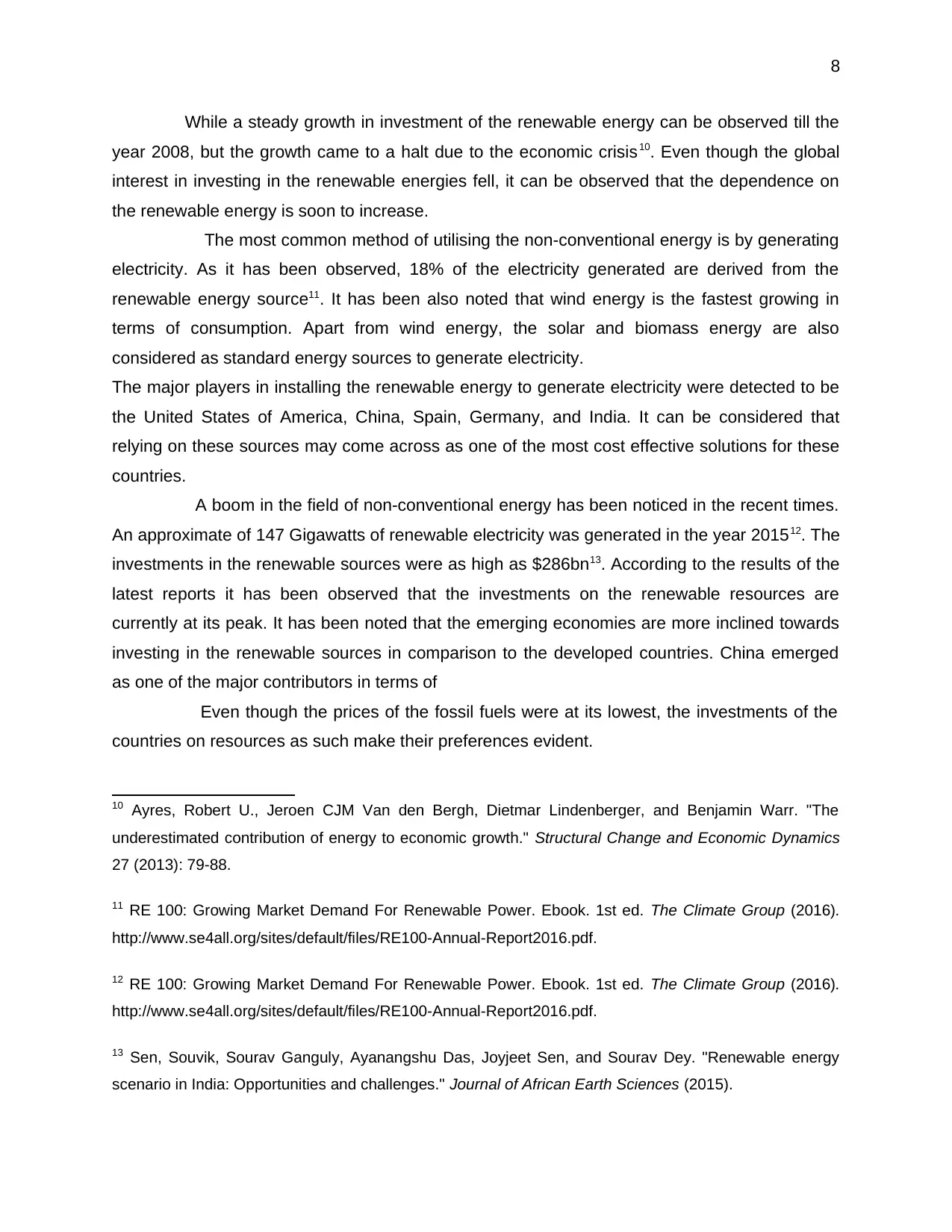
8
While a steady growth in investment of the renewable energy can be observed till the
year 2008, but the growth came to a halt due to the economic crisis10. Even though the global
interest in investing in the renewable energies fell, it can be observed that the dependence on
the renewable energy is soon to increase.
The most common method of utilising the non-conventional energy is by generating
electricity. As it has been observed, 18% of the electricity generated are derived from the
renewable energy source11. It has been also noted that wind energy is the fastest growing in
terms of consumption. Apart from wind energy, the solar and biomass energy are also
considered as standard energy sources to generate electricity.
The major players in installing the renewable energy to generate electricity were detected to be
the United States of America, China, Spain, Germany, and India. It can be considered that
relying on these sources may come across as one of the most cost effective solutions for these
countries.
A boom in the field of non-conventional energy has been noticed in the recent times.
An approximate of 147 Gigawatts of renewable electricity was generated in the year 201512. The
investments in the renewable sources were as high as $286bn13. According to the results of the
latest reports it has been observed that the investments on the renewable resources are
currently at its peak. It has been noted that the emerging economies are more inclined towards
investing in the renewable sources in comparison to the developed countries. China emerged
as one of the major contributors in terms of
Even though the prices of the fossil fuels were at its lowest, the investments of the
countries on resources as such make their preferences evident.
10 Ayres, Robert U., Jeroen CJM Van den Bergh, Dietmar Lindenberger, and Benjamin Warr. "The
underestimated contribution of energy to economic growth." Structural Change and Economic Dynamics
27 (2013): 79-88.
11 RE 100: Growing Market Demand For Renewable Power. Ebook. 1st ed. The Climate Group (2016).
http://www.se4all.org/sites/default/files/RE100-Annual-Report2016.pdf.
12 RE 100: Growing Market Demand For Renewable Power. Ebook. 1st ed. The Climate Group (2016).
http://www.se4all.org/sites/default/files/RE100-Annual-Report2016.pdf.
13 Sen, Souvik, Sourav Ganguly, Ayanangshu Das, Joyjeet Sen, and Sourav Dey. "Renewable energy
scenario in India: Opportunities and challenges." Journal of African Earth Sciences (2015).
While a steady growth in investment of the renewable energy can be observed till the
year 2008, but the growth came to a halt due to the economic crisis10. Even though the global
interest in investing in the renewable energies fell, it can be observed that the dependence on
the renewable energy is soon to increase.
The most common method of utilising the non-conventional energy is by generating
electricity. As it has been observed, 18% of the electricity generated are derived from the
renewable energy source11. It has been also noted that wind energy is the fastest growing in
terms of consumption. Apart from wind energy, the solar and biomass energy are also
considered as standard energy sources to generate electricity.
The major players in installing the renewable energy to generate electricity were detected to be
the United States of America, China, Spain, Germany, and India. It can be considered that
relying on these sources may come across as one of the most cost effective solutions for these
countries.
A boom in the field of non-conventional energy has been noticed in the recent times.
An approximate of 147 Gigawatts of renewable electricity was generated in the year 201512. The
investments in the renewable sources were as high as $286bn13. According to the results of the
latest reports it has been observed that the investments on the renewable resources are
currently at its peak. It has been noted that the emerging economies are more inclined towards
investing in the renewable sources in comparison to the developed countries. China emerged
as one of the major contributors in terms of
Even though the prices of the fossil fuels were at its lowest, the investments of the
countries on resources as such make their preferences evident.
10 Ayres, Robert U., Jeroen CJM Van den Bergh, Dietmar Lindenberger, and Benjamin Warr. "The
underestimated contribution of energy to economic growth." Structural Change and Economic Dynamics
27 (2013): 79-88.
11 RE 100: Growing Market Demand For Renewable Power. Ebook. 1st ed. The Climate Group (2016).
http://www.se4all.org/sites/default/files/RE100-Annual-Report2016.pdf.
12 RE 100: Growing Market Demand For Renewable Power. Ebook. 1st ed. The Climate Group (2016).
http://www.se4all.org/sites/default/files/RE100-Annual-Report2016.pdf.
13 Sen, Souvik, Sourav Ganguly, Ayanangshu Das, Joyjeet Sen, and Sourav Dey. "Renewable energy
scenario in India: Opportunities and challenges." Journal of African Earth Sciences (2015).
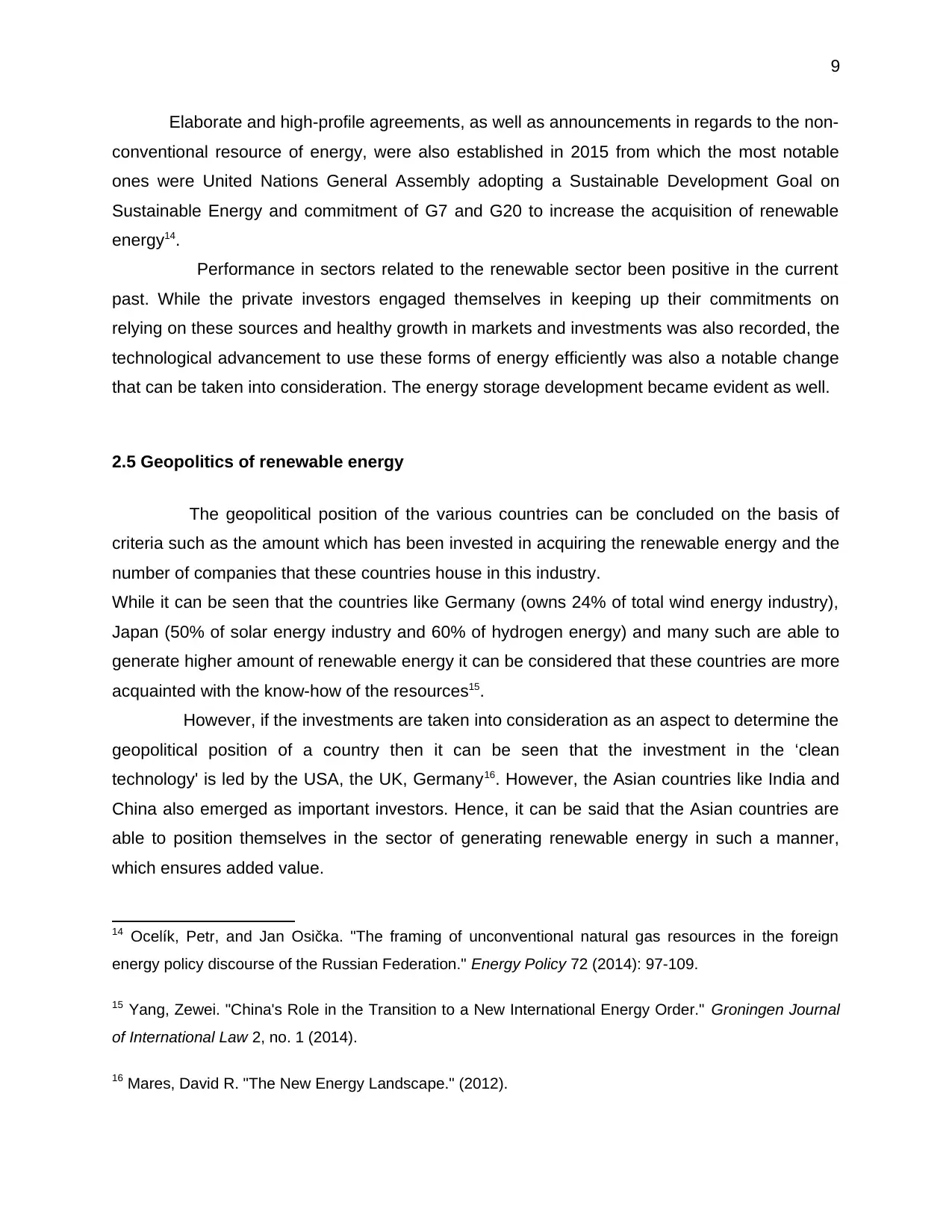
9
Elaborate and high-profile agreements, as well as announcements in regards to the non-
conventional resource of energy, were also established in 2015 from which the most notable
ones were United Nations General Assembly adopting a Sustainable Development Goal on
Sustainable Energy and commitment of G7 and G20 to increase the acquisition of renewable
energy14.
Performance in sectors related to the renewable sector been positive in the current
past. While the private investors engaged themselves in keeping up their commitments on
relying on these sources and healthy growth in markets and investments was also recorded, the
technological advancement to use these forms of energy efficiently was also a notable change
that can be taken into consideration. The energy storage development became evident as well.
2.5 Geopolitics of renewable energy
The geopolitical position of the various countries can be concluded on the basis of
criteria such as the amount which has been invested in acquiring the renewable energy and the
number of companies that these countries house in this industry.
While it can be seen that the countries like Germany (owns 24% of total wind energy industry),
Japan (50% of solar energy industry and 60% of hydrogen energy) and many such are able to
generate higher amount of renewable energy it can be considered that these countries are more
acquainted with the know-how of the resources15.
However, if the investments are taken into consideration as an aspect to determine the
geopolitical position of a country then it can be seen that the investment in the ‘clean
technology' is led by the USA, the UK, Germany16. However, the Asian countries like India and
China also emerged as important investors. Hence, it can be said that the Asian countries are
able to position themselves in the sector of generating renewable energy in such a manner,
which ensures added value.
14 Ocelík, Petr, and Jan Osička. "The framing of unconventional natural gas resources in the foreign
energy policy discourse of the Russian Federation." Energy Policy 72 (2014): 97-109.
15 Yang, Zewei. "China's Role in the Transition to a New International Energy Order." Groningen Journal
of International Law 2, no. 1 (2014).
16 Mares, David R. "The New Energy Landscape." (2012).
Elaborate and high-profile agreements, as well as announcements in regards to the non-
conventional resource of energy, were also established in 2015 from which the most notable
ones were United Nations General Assembly adopting a Sustainable Development Goal on
Sustainable Energy and commitment of G7 and G20 to increase the acquisition of renewable
energy14.
Performance in sectors related to the renewable sector been positive in the current
past. While the private investors engaged themselves in keeping up their commitments on
relying on these sources and healthy growth in markets and investments was also recorded, the
technological advancement to use these forms of energy efficiently was also a notable change
that can be taken into consideration. The energy storage development became evident as well.
2.5 Geopolitics of renewable energy
The geopolitical position of the various countries can be concluded on the basis of
criteria such as the amount which has been invested in acquiring the renewable energy and the
number of companies that these countries house in this industry.
While it can be seen that the countries like Germany (owns 24% of total wind energy industry),
Japan (50% of solar energy industry and 60% of hydrogen energy) and many such are able to
generate higher amount of renewable energy it can be considered that these countries are more
acquainted with the know-how of the resources15.
However, if the investments are taken into consideration as an aspect to determine the
geopolitical position of a country then it can be seen that the investment in the ‘clean
technology' is led by the USA, the UK, Germany16. However, the Asian countries like India and
China also emerged as important investors. Hence, it can be said that the Asian countries are
able to position themselves in the sector of generating renewable energy in such a manner,
which ensures added value.
14 Ocelík, Petr, and Jan Osička. "The framing of unconventional natural gas resources in the foreign
energy policy discourse of the Russian Federation." Energy Policy 72 (2014): 97-109.
15 Yang, Zewei. "China's Role in the Transition to a New International Energy Order." Groningen Journal
of International Law 2, no. 1 (2014).
16 Mares, David R. "The New Energy Landscape." (2012).
⊘ This is a preview!⊘
Do you want full access?
Subscribe today to unlock all pages.

Trusted by 1+ million students worldwide
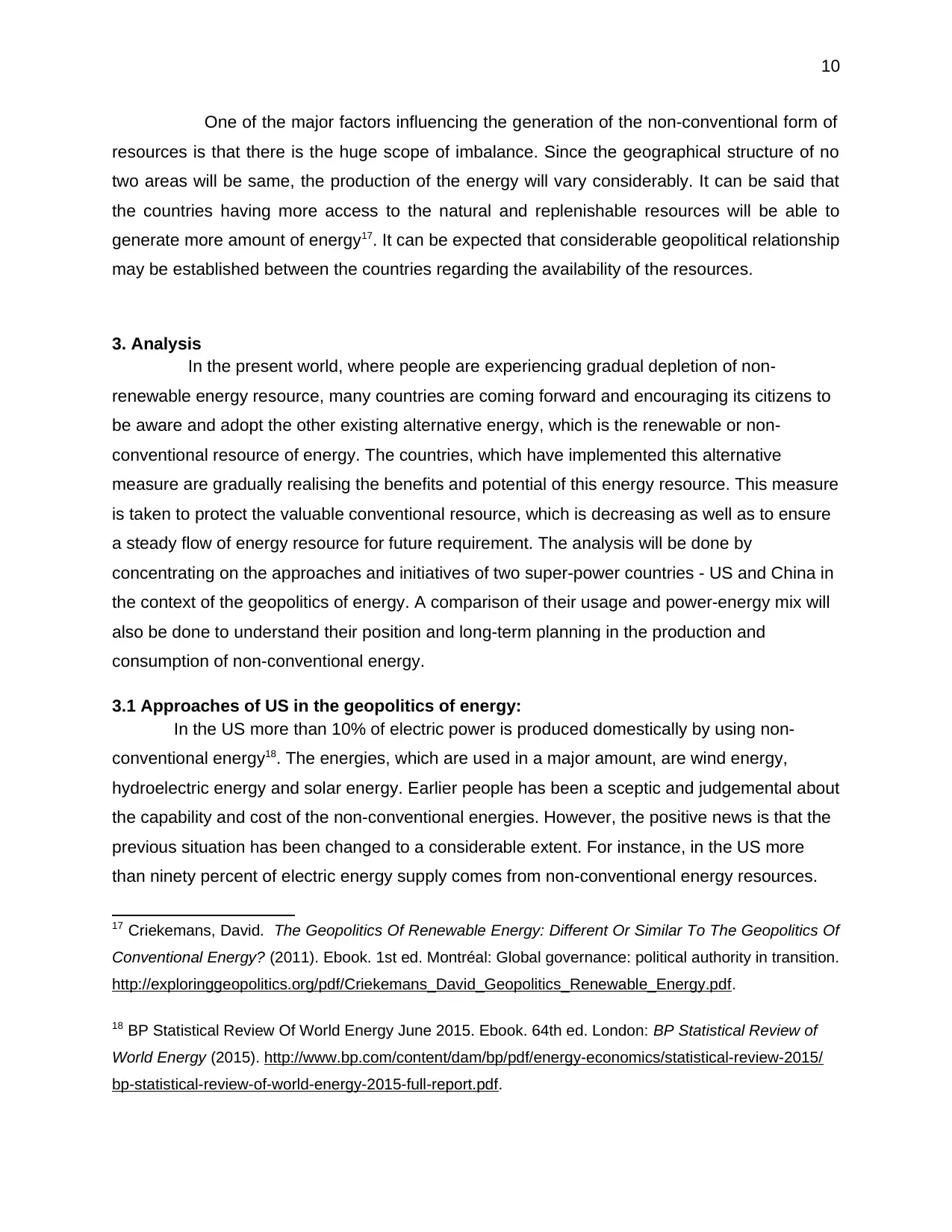
10
One of the major factors influencing the generation of the non-conventional form of
resources is that there is the huge scope of imbalance. Since the geographical structure of no
two areas will be same, the production of the energy will vary considerably. It can be said that
the countries having more access to the natural and replenishable resources will be able to
generate more amount of energy17. It can be expected that considerable geopolitical relationship
may be established between the countries regarding the availability of the resources.
3. Analysis
In the present world, where people are experiencing gradual depletion of non-
renewable energy resource, many countries are coming forward and encouraging its citizens to
be aware and adopt the other existing alternative energy, which is the renewable or non-
conventional resource of energy. The countries, which have implemented this alternative
measure are gradually realising the benefits and potential of this energy resource. This measure
is taken to protect the valuable conventional resource, which is decreasing as well as to ensure
a steady flow of energy resource for future requirement. The analysis will be done by
concentrating on the approaches and initiatives of two super-power countries - US and China in
the context of the geopolitics of energy. A comparison of their usage and power-energy mix will
also be done to understand their position and long-term planning in the production and
consumption of non-conventional energy.
3.1 Approaches of US in the geopolitics of energy:
In the US more than 10% of electric power is produced domestically by using non-
conventional energy18. The energies, which are used in a major amount, are wind energy,
hydroelectric energy and solar energy. Earlier people has been a sceptic and judgemental about
the capability and cost of the non-conventional energies. However, the positive news is that the
previous situation has been changed to a considerable extent. For instance, in the US more
than ninety percent of electric energy supply comes from non-conventional energy resources.
17 Criekemans, David. The Geopolitics Of Renewable Energy: Different Or Similar To The Geopolitics Of
Conventional Energy? (2011). Ebook. 1st ed. Montréal: Global governance: political authority in transition.
http://exploringgeopolitics.org/pdf/Criekemans_David_Geopolitics_Renewable_Energy.pdf.
18 BP Statistical Review Of World Energy June 2015. Ebook. 64th ed. London: BP Statistical Review of
World Energy (2015). http://www.bp.com/content/dam/bp/pdf/energy-economics/statistical-review-2015/
bp-statistical-review-of-world-energy-2015-full-report.pdf.
One of the major factors influencing the generation of the non-conventional form of
resources is that there is the huge scope of imbalance. Since the geographical structure of no
two areas will be same, the production of the energy will vary considerably. It can be said that
the countries having more access to the natural and replenishable resources will be able to
generate more amount of energy17. It can be expected that considerable geopolitical relationship
may be established between the countries regarding the availability of the resources.
3. Analysis
In the present world, where people are experiencing gradual depletion of non-
renewable energy resource, many countries are coming forward and encouraging its citizens to
be aware and adopt the other existing alternative energy, which is the renewable or non-
conventional resource of energy. The countries, which have implemented this alternative
measure are gradually realising the benefits and potential of this energy resource. This measure
is taken to protect the valuable conventional resource, which is decreasing as well as to ensure
a steady flow of energy resource for future requirement. The analysis will be done by
concentrating on the approaches and initiatives of two super-power countries - US and China in
the context of the geopolitics of energy. A comparison of their usage and power-energy mix will
also be done to understand their position and long-term planning in the production and
consumption of non-conventional energy.
3.1 Approaches of US in the geopolitics of energy:
In the US more than 10% of electric power is produced domestically by using non-
conventional energy18. The energies, which are used in a major amount, are wind energy,
hydroelectric energy and solar energy. Earlier people has been a sceptic and judgemental about
the capability and cost of the non-conventional energies. However, the positive news is that the
previous situation has been changed to a considerable extent. For instance, in the US more
than ninety percent of electric energy supply comes from non-conventional energy resources.
17 Criekemans, David. The Geopolitics Of Renewable Energy: Different Or Similar To The Geopolitics Of
Conventional Energy? (2011). Ebook. 1st ed. Montréal: Global governance: political authority in transition.
http://exploringgeopolitics.org/pdf/Criekemans_David_Geopolitics_Renewable_Energy.pdf.
18 BP Statistical Review Of World Energy June 2015. Ebook. 64th ed. London: BP Statistical Review of
World Energy (2015). http://www.bp.com/content/dam/bp/pdf/energy-economics/statistical-review-2015/
bp-statistical-review-of-world-energy-2015-full-report.pdf.
Paraphrase This Document
Need a fresh take? Get an instant paraphrase of this document with our AI Paraphraser
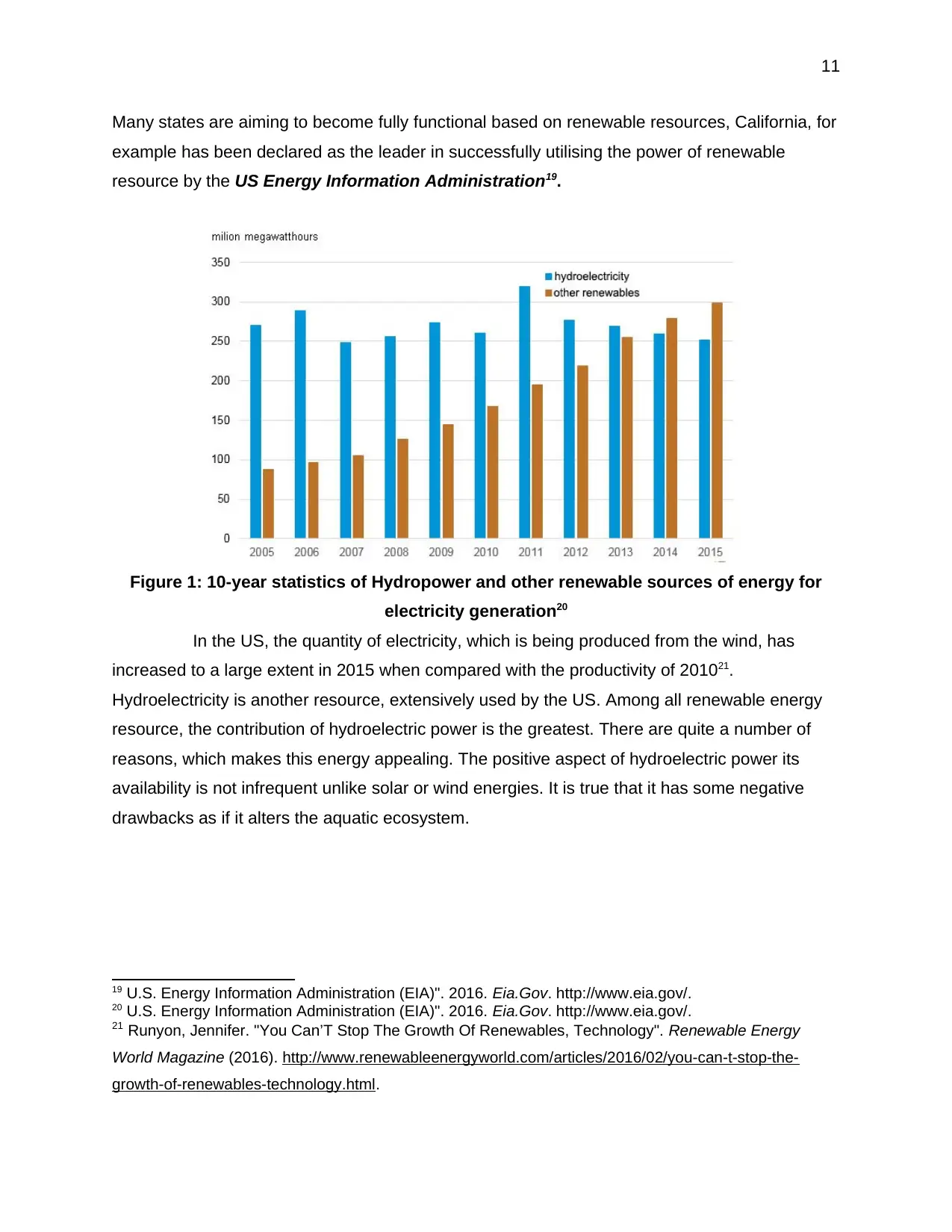
11
Many states are aiming to become fully functional based on renewable resources, California, for
example has been declared as the leader in successfully utilising the power of renewable
resource by the US Energy Information Administration19.
Figure 1: 10-year statistics of Hydropower and other renewable sources of energy for
electricity generation20
In the US, the quantity of electricity, which is being produced from the wind, has
increased to a large extent in 2015 when compared with the productivity of 201021.
Hydroelectricity is another resource, extensively used by the US. Among all renewable energy
resource, the contribution of hydroelectric power is the greatest. There are quite a number of
reasons, which makes this energy appealing. The positive aspect of hydroelectric power its
availability is not infrequent unlike solar or wind energies. It is true that it has some negative
drawbacks as if it alters the aquatic ecosystem.
19 U.S. Energy Information Administration (EIA)". 2016. Eia.Gov. http://www.eia.gov/.
20 U.S. Energy Information Administration (EIA)". 2016. Eia.Gov. http://www.eia.gov/.
21 Runyon, Jennifer. "You Can’T Stop The Growth Of Renewables, Technology". Renewable Energy
World Magazine (2016). http://www.renewableenergyworld.com/articles/2016/02/you-can-t-stop-the-
growth-of-renewables-technology.html.
Many states are aiming to become fully functional based on renewable resources, California, for
example has been declared as the leader in successfully utilising the power of renewable
resource by the US Energy Information Administration19.
Figure 1: 10-year statistics of Hydropower and other renewable sources of energy for
electricity generation20
In the US, the quantity of electricity, which is being produced from the wind, has
increased to a large extent in 2015 when compared with the productivity of 201021.
Hydroelectricity is another resource, extensively used by the US. Among all renewable energy
resource, the contribution of hydroelectric power is the greatest. There are quite a number of
reasons, which makes this energy appealing. The positive aspect of hydroelectric power its
availability is not infrequent unlike solar or wind energies. It is true that it has some negative
drawbacks as if it alters the aquatic ecosystem.
19 U.S. Energy Information Administration (EIA)". 2016. Eia.Gov. http://www.eia.gov/.
20 U.S. Energy Information Administration (EIA)". 2016. Eia.Gov. http://www.eia.gov/.
21 Runyon, Jennifer. "You Can’T Stop The Growth Of Renewables, Technology". Renewable Energy
World Magazine (2016). http://www.renewableenergyworld.com/articles/2016/02/you-can-t-stop-the-
growth-of-renewables-technology.html.
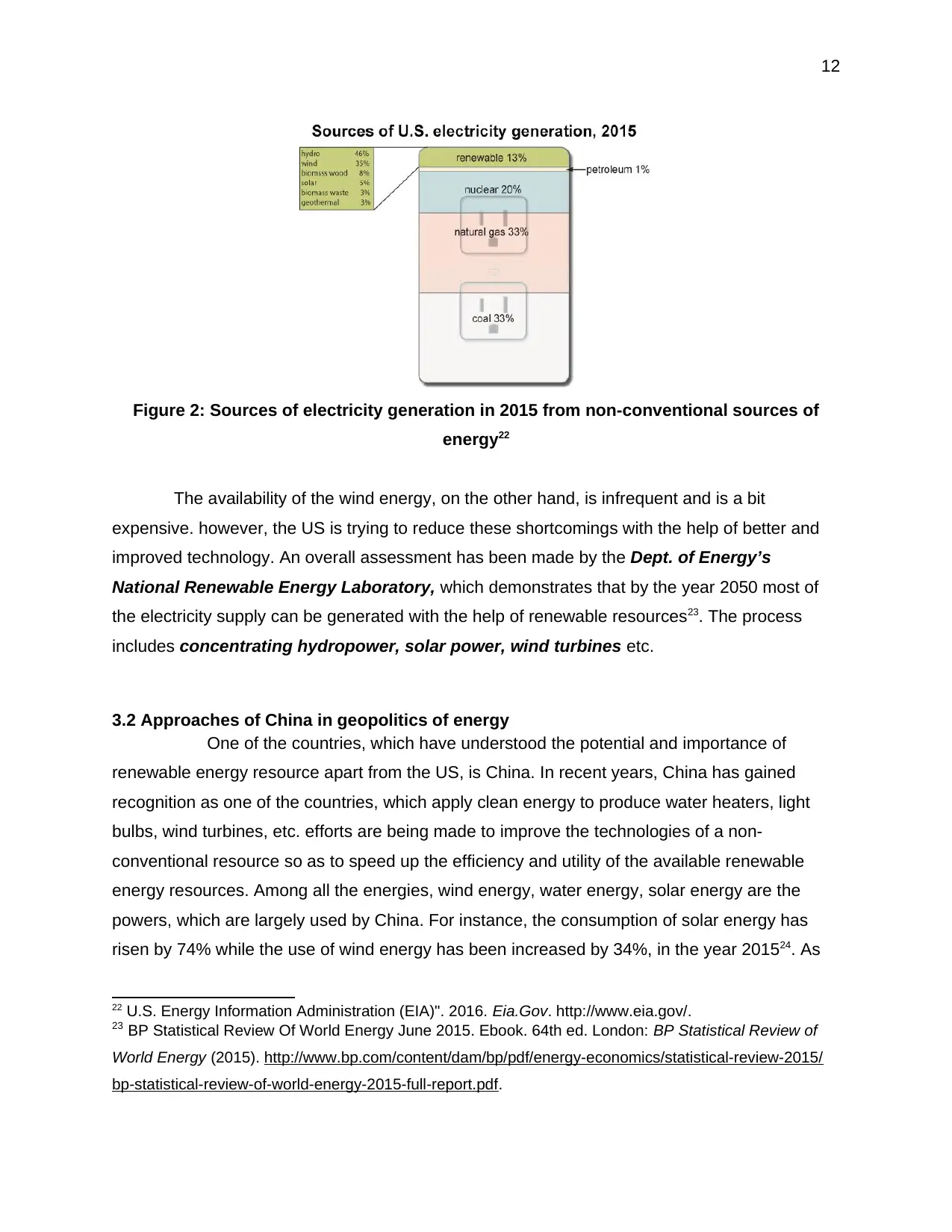
12
Figure 2: Sources of electricity generation in 2015 from non-conventional sources of
energy22
The availability of the wind energy, on the other hand, is infrequent and is a bit
expensive. however, the US is trying to reduce these shortcomings with the help of better and
improved technology. An overall assessment has been made by the Dept. of Energy’s
National Renewable Energy Laboratory, which demonstrates that by the year 2050 most of
the electricity supply can be generated with the help of renewable resources23. The process
includes concentrating hydropower, solar power, wind turbines etc.
3.2 Approaches of China in geopolitics of energy
One of the countries, which have understood the potential and importance of
renewable energy resource apart from the US, is China. In recent years, China has gained
recognition as one of the countries, which apply clean energy to produce water heaters, light
bulbs, wind turbines, etc. efforts are being made to improve the technologies of a non-
conventional resource so as to speed up the efficiency and utility of the available renewable
energy resources. Among all the energies, wind energy, water energy, solar energy are the
powers, which are largely used by China. For instance, the consumption of solar energy has
risen by 74% while the use of wind energy has been increased by 34%, in the year 201524. As
22 U.S. Energy Information Administration (EIA)". 2016. Eia.Gov. http://www.eia.gov/.
23 BP Statistical Review Of World Energy June 2015. Ebook. 64th ed. London: BP Statistical Review of
World Energy (2015). http://www.bp.com/content/dam/bp/pdf/energy-economics/statistical-review-2015/
bp-statistical-review-of-world-energy-2015-full-report.pdf.
Figure 2: Sources of electricity generation in 2015 from non-conventional sources of
energy22
The availability of the wind energy, on the other hand, is infrequent and is a bit
expensive. however, the US is trying to reduce these shortcomings with the help of better and
improved technology. An overall assessment has been made by the Dept. of Energy’s
National Renewable Energy Laboratory, which demonstrates that by the year 2050 most of
the electricity supply can be generated with the help of renewable resources23. The process
includes concentrating hydropower, solar power, wind turbines etc.
3.2 Approaches of China in geopolitics of energy
One of the countries, which have understood the potential and importance of
renewable energy resource apart from the US, is China. In recent years, China has gained
recognition as one of the countries, which apply clean energy to produce water heaters, light
bulbs, wind turbines, etc. efforts are being made to improve the technologies of a non-
conventional resource so as to speed up the efficiency and utility of the available renewable
energy resources. Among all the energies, wind energy, water energy, solar energy are the
powers, which are largely used by China. For instance, the consumption of solar energy has
risen by 74% while the use of wind energy has been increased by 34%, in the year 201524. As
22 U.S. Energy Information Administration (EIA)". 2016. Eia.Gov. http://www.eia.gov/.
23 BP Statistical Review Of World Energy June 2015. Ebook. 64th ed. London: BP Statistical Review of
World Energy (2015). http://www.bp.com/content/dam/bp/pdf/energy-economics/statistical-review-2015/
bp-statistical-review-of-world-energy-2015-full-report.pdf.
⊘ This is a preview!⊘
Do you want full access?
Subscribe today to unlock all pages.

Trusted by 1+ million students worldwide
1 out of 17
Your All-in-One AI-Powered Toolkit for Academic Success.
+13062052269
info@desklib.com
Available 24*7 on WhatsApp / Email
![[object Object]](/_next/static/media/star-bottom.7253800d.svg)
Unlock your academic potential
Copyright © 2020–2025 A2Z Services. All Rights Reserved. Developed and managed by ZUCOL.